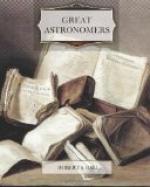BRADLEY.
James Bradley was descended from an ancient family in the county of Durham. He was born in 1692 or 1693, at Sherbourne, in Gloucestershire, and was educated in the Grammar School at Northleach. From thence he proceeded in due course to Oxford, where he was admitted a commoner at Balliol College, on March 15th, 1711. Much of his time, while an undergraduate, was passed in Essex with his maternal uncle, the Rev. James Pound, who was a well-known man of science and a diligent observer of the stars. It was doubtless by intercourse with his uncle that young Bradley became so expert in the use of astronomical instruments, but the immortal discoveries he subsequently made show him to have been a born astronomer.
The first exhibition of Bradley’s practical skill seems to be contained in two observations which he made in 1717 and 1718. They have been published by Halley, whose acuteness had led him to perceive the extraordinary scientific talents of the young astronomer. Another illustration of the sagacity which Bradley manifested, even at the very commencement of his astronomical career, is contained in a remark of Halley’s, who says: “Dr. Pound and his nephew, Mr. Bradley, did, myself being present, in the last opposition of the sun and Mars this way demonstrate the extreme minuteness of the sun’s parallax, and that it was not more than twelve seconds nor less than nine seconds.” To make the significance of this plain, it should be observed that the determination of the sun’s parallax is equivalent to the determination of the distance from the earth to the sun. At the time of which we are now writing, this very important unit of celestial measurement was only very imperfectly known, and the observations of Pound and Bradley may be interpreted to mean that, from their observations, they had come to the conclusion that the distance from the earth to the sun must be more than 94 millions of miles, and less than 125 millions. We now, of course, know that they were not exactly right, for the true distance of the sun is about 93 millions of miles. We cannot, however, but think that it was a very remarkable approach for the veteran astronomer and his brilliant nephew to make towards the determination of a magnitude which did not become accurately known till fifty years later.
Among the earliest parts of astronomical work to which Bradley’s attention was directed, were the eclipses of Jupiter’s satellites. These phenomena are specially attractive inasmuch as they can be so readily observed, and Bradley found it extremely interesting to calculate the times at which the eclipses should take place, and then to compare his observations with the predicted times. From the success that he met with in this work, and from his other labours, Bradley’s reputation as an astronomer increased so greatly that on November the 6th, 1718, he was elected a Fellow of the Royal Society.




